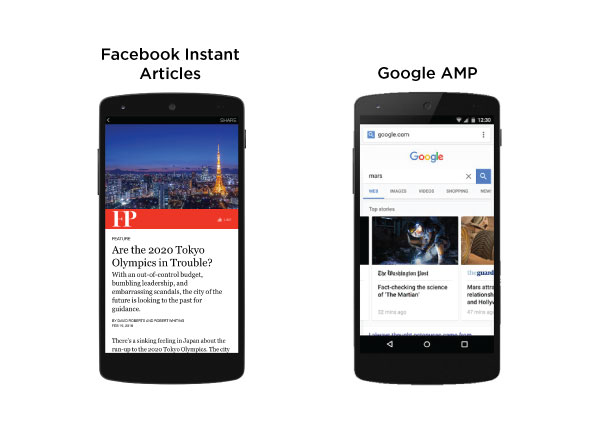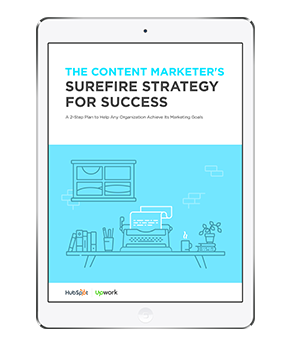
As the mobile web has overtaken desktop as the primary way people access content online, the way publications design and display webpages has taken on increasing importance. Mobile is a notoriously tricky platform. Limited data plans, fickle networks, and slower processing speeds mean that website owners need to be especially conscious of how their pages are built and displayed. Especially on mobile devices, poorly designed or slow-loading pages can dramatically increase bounce rates and result in lost ad revenue.
In 2015, Facebook and Google introduced initiatives designed to improve the mobile web experience for users. Both share the goal of making pages that load faster and use less data than desktop pages. In this article, we’ll look at how Facebook Instant Articles and Google Accelerated Mobile Pages (AMP) compare, so you and your content team can be prepared before you make any changes to your mobile content strategy.
What Are They Exactly?
At their most basic level, both Facebook Instant Articles and Google AMP are designed to help content (specifically static content, like words and pictures) load faster on mobile devices than a typical web page. In the specifics of their design and execution, though, there are some real differences.
First, let’s look at how users access each type of page. Facebook Instant Articles works inside the Facebook app, allowing brands to publish articles directly into Facebook’s News Feed rather than relying on outbound links. That means users can open and read entire articles within the Facebook app. For Facebook, this is a huge advantage, as it gives users one less reason to leave the app while also potentially generating ad revenue for Facebook.
Google Accelerated Mobile Pages work a bit differently. Where Facebook Instant Articles only appear inside the Facebook app, AMP articles appear inside your mobile web browser on Google search results pages. That makes them feel less like a whole new experience than an optimized version of traditional mobile web pages. The only thing that distinguishes them from typical search results is that they appear in a carousel at the top of the search results page and feature publication logos and thumbnail images that help them stand out. In order to spur adoption of the AMP standard, Google is also encouraging other sites, like Twitter and Pinterest, to support embedding AMP pages on their services as well.
How Do They Work?
Relying on the same technology Facebook uses to quickly load videos and photos, Instant Articles come with a number of multimedia bells and whistles, including autoplaying videos, interactive maps, and explorable photos. These articles are built using HTML5, and publishers are required to submit a properly formatted sample to be approved by Facebook before they can begin distributing to Instant Articles. Once they’ve been approved, though, publishers are able to syndicate Instant Articles directly from their existing content management systems, either through the Instant Articles API or with a secure RSS feed.
While many publishers remain wary of encouraging their readers to stay in Facebook’s app (rather than visiting their own mobile websites), the results can be dramatic. According to Facebook, Instant Articles are shared 30 percent more often than mobile web articles, load 10x more quickly, and are 70 percent less likely to be abandoned.
Rather than building a new product, Google has opted to go with an optimized version of the traditional mobile web experience. The key here is preloading, meaning that Google begins caching and prerendering content before you even tap on an article. Preloading has been around for a long time, but Google has taken this technology to the next level. Not surprisingly, the fewer assets you have to load, the quicker this process becomes. That’s why Google has opted to go with a radically stripped down subset of HTML for AMP called AMP HTML. Where Facebook Instant Articles takes advantage of HTML5’s multimedia and rich storytelling capabilities, Google AMP emphasizes static content over interactive, disallowing JavaScript and third-party scripts, two features that are common to modern webpages.
By cutting out JavaScript and slow-loading parts of HTML, Google AMP is able to dramatically decrease load times. Per Google, AMP articles load 4x faster than standard webpages while using 10x less data.
How Do They Compare?
Both programs aim to make content on the mobile web faster and easier for users to access and enjoy. That said, they both require investments of time and resources on the part of content creators, so how do you decide which (if either) program is right for your organization? Let’s take a look at how they compare in terms of potential reach, ease of use, and how they handle ad revenue.
Reach
It’s hard to compare usage statistics directly, but it’s safe to say that both Google and Facebook reach massive audiences on a daily basis. Google processes more than 3.5 billion searches per day, while Facebook’s 1.65+ billion users spend up to 20 percent of their time online using Facebook. When choosing which platform to go with, it’s important to be cognizant of where your audience is and how they currently access your content. Are more people finding your content through organic search? Or from social shares?
Ease of Use
Many of the technologies disallowed by AMP HTML, like iframes and JavaScript, are considered foundational to modern websites. As a result, publishers who want to create articles for Google AMP are essentially required to create parallel versions of their content, which is a significant investment of time and resources.
By contrast, Facebook has tried to make getting up and running with Instant Articles as simple as possible. The entire process can be managed from publishers’ existing content management systems, and they can begin syndicating all their content to Instant Articles with the flip of a switch.
Ad Revenue
Facebook Instant Articles is a business partnership. There are two routes here. Publishers who sell and serve their own ads keep 100 percent of the revenue generated by the ads within Instant Articles. Publishers also have the option of allowing Facebook to sell ads on their behalf through its own mobile ad network, in which case Facebook takes a 30 percent cut. Initially, some publishers were unhappy about generating less revenue from Instant Articles than from their own mobile websites. Since Facebook changed some of its ad restrictions, however, many publishers have reported seeing parity in ad revenue across their mobile sites and Facebook Instant Articles.
Google AMP is a little different. It’s an open-source initiative, not a business partnership. Rather than trying to keep users within a particular app, as Facebook aims to do, Google is more interested in changing the way publishers build mobile webpages. Google is creating standards and best practices that it hopes content creators will adopt so that its search engine can direct users to the best mobile experiences.
The Bottom Line
Whichever platform you use, you’re going to need to think about how you create and design content to make the most of each platform’s advantages and limitations. Looking for content writers, developers, or marketing experts to help you get your content operation up and running? Explore freelancers on Upwork.
Upwork Ebook: Create Results Driven Content
Essential Tips for the Smart Marketer

